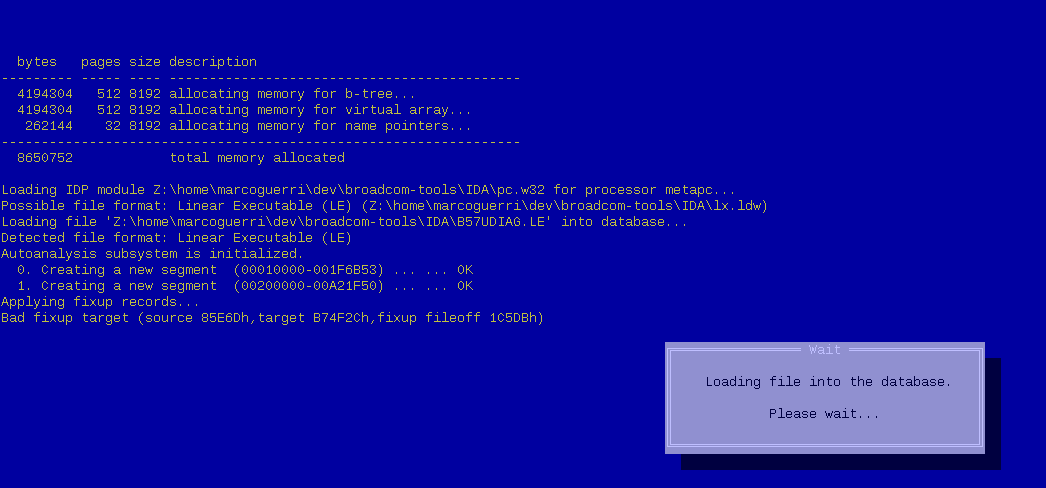Reverse engineering MS-DOS binaries
I have reverse engineered some control paths of an old MS-DOS tool from Broadcom which came as a UPX compressed linear executable prepended with Protected Mode extender and required tools such as IDA 4.1, IDA 5.0, to be reverse engineered. This post is a collection of notes explaining how to get from binary to disassembled and decompiled code for applications packaged in a similar way.
MS-DOS protected mode extender
The following is what file shows on the tool:
$ file B57UDIAG.EXE
B57UDIAG.EXE: MS-DOS executable, LE executable for MS-DOS, PMODE/W DOS extender, UPX compressed
After going through the first compressed layer,
Expand code - Upx decompression
$ upx -d B57UDIAG.EXE
Ultimate Packer for eXecutables
Copyright (C) 1996 - 2023
UPX 4.0.2 Markus Oberhumer, Laszlo Molnar & John Reiser Jan 30th 2023
File size Ratio Format Name
-------------------- ------ ----------- -----------
800005 <- 243351 30.42% watcom/le B57UDIAG.EXE
Unpacked 1 file.
$ file B57UDIAG.EXE
B57UDIAG.EXE: MS-DOS executable, LE executable for MS-DOS, PMODE/W DOS extender
we get a Linear Executable with PMODE/W DOS extender. PMODE/W is a stub
prepended to the original binary which implements DOS Protected Mode Interface and enables protected mode programs
to run in MS-DOS environment, with access to all system memory available. The extender takes care of the complexity
coming from supporting protected mode, such as descriptor tables and memory management. Application code in B57UDIAG.EXE
does not seem to be compressed by PMODE/W (strings does return what we would expect to see from the Broadcom tool),
however IDA does not recognize the Linear Executable and disassembles only PMODE/W stub, so the two need
to be split up.
As a side note, if application code was compressed by PMODE/W, a tool called PMWUNLIT.EXE (version v1.20, mentioned in multiple places online such as [1], [2], [3]) can be used for the extraction.
Expand code - PMWUNLIT.EXE sha256
sha256 of PMWUNLIT.EXE: dcbdaf0665b4d252620e0ff786a05e7c0ca9d9ee42986fe1d942ef0359db68be
PMWUNLIT.EXE runs in MS-DOS, but it should be totally doable to build a modern alternative
based on PMODE/W source code (as of July 2023, PMODE/W is released under MIT license).
In order to separate PMODE/W stub and application code, DOS/32 extender is distrubuted with a tool
which is capable of removing the stub, also working with PMODE/W. The tool is called sb.exe and
is packaged in dos32a-912-bin.zip, of which I could find a copy only on Internet Archive. Running sb.exe on the upx unpacked B57UDIAG.EXE file results
in the extraction of the LE binary:
C:\>sb.exe /U B57UDIAG.EXE
SB/32A -- Bind Utility version 9.1.2
Copyright (C) 1996-2006 by Narech K.
Application Name: "B57UDIAG.EXE"
Application Size: 3165490 bytes
Application Type: PMODE/W DOS Extender bound to
LE-style file format Linear Executable
Unbinding file: "B57UDIAG.EXE"
Destination file: "B57UDIAG.le"
Destination size: 3153970 bytes (99.6%)
Disassembling LE binaries
We now have a linear executable binary and we need a disassembler which is capable of dissecting this format.
All pointers I gathered onlined suggested that IDA 4.1 is the last free version of IDA disassembler which can
open LEs. The alternative is to use IDA Pro. IDA 4.1 is a console application for Windows 32 bits and can be
executed via wine (wineconsole). Reverse engineering can however take place in a more modern environment, as IDA 4.1
serves just as an extractor to build the disassembler database (idb file). IDA Freeware 5.0 is the latest version capable
of opening the idb file generated by IDA 4.1 and it is the one I extensively used to analyze B57UDIAG.EXE.
The alternative to IDA is using Ghidra with custom LE loaders, such as ghidra-lx-loader. For my extercise on Broadcom tool, I used both. Admittedly, I found IDA to be more reliable in disassembling application code.
The availability of the two versions of IDA mentioned above is as follows:
- IDA Freeware 5.0 can be sourced from ScummVM, who got permissions to re-distribute the binary.
- IDA 4.1 can be found online from repositories of old MS-DOS tools
Once the Linear Executable has been split from PMODE/W stub, it can be simply loaded into IDA 4.1 to generate the database.
The idb file can then be fed into IDA Freeware 5.0 in a modern Windows environment.
